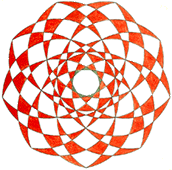
|
Remo F. Roth
Dr. oec. publ., Ph.D.
dipl. analyt. Psychologe (M.-L. v. Franz)
|
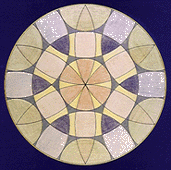
|
email
HomePage
Remo Rothe
WebSite
Psychovision
© copyright 1996
by Remo F. Roth, Zurich, Switzerland
Synchronicity
Quest (Die Gottsucher)
The Common
Depthpsychological Background of Alchemy, Christian Mysticism and
Quantum Physics
Summary of the
Manuscript
by Remo F.
ROTH
"(...) Jung found
further that the mandala does not only mirror an inner state of
order, but that its harmony or disharmony encompasses also the
surroundings of the individual. Thus a mandala needs a symbol in
which the outer and inner world merge. There is for Jung a ultimate
reality beyond matter and psyche which he called the unus mundus, its
empirical manifestation is the principle of synchronicity because in
synchronistic events the inner world behaves as if it were outside
and the outer world as if it were inside. As the mandala symbolism
expresses the holistic order of matter and psyche it should have been
investigated by physicists as well as psychologists because the
mandala reappears in their hypothetical models of the atomic world.
The atomic model of Niels Bohr is already a cosmic mandala and the
models which the physicists construct nowadays to visualize the
quarks are also mandalas. It is therefore a merit of Dr. Remo Roth's
book to pick up that neglected subject which is of the utmost
importance, and I hope that it will provoke further widespread
serious discussion of the subject (...)"
From the foreword by
Marie-Louise von Franz
German title:
Die Gottsucher
Eine Vereinigung der
christlichen Mystik
und der
Quantenphysik
in der Synchronizität
C.G. Jungs
Verlag Haag &
Herchen,Frankfurt, 1992
Italian
translation:
I cercatori di Dio
Una riunificatione della
mistica cristiana e della fisica dei quanti
nella sincronicità di
C.G. Jung
Di Renzo Editore, Roma, 1994
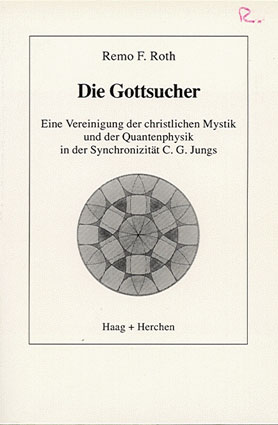 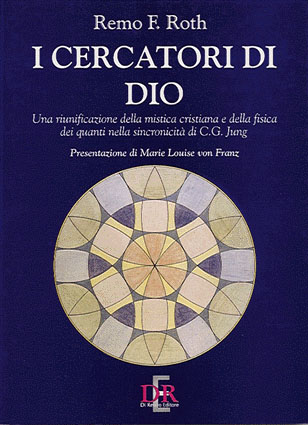
Why are young people of the
twentieth century suddenly so interested in Sufism and Tantrism? What
prompts Fritjof Capra to compare the discoveries of quantum physics
with the representations of Far Eastern mystics? What deeper reality
might lie behind the disaster of Chernobyl?
It is one of the purposes of
this manuscript to demonstrate that these phenomena are all
expressions of an unconscious transformation of the god image (the
Self of C.G. Jung) which has occurred during the two thousand years
of Christian history. We can recognize this archetypal process in the
beliefs of the mystics of the Heart of Jesus Christ in the 12th
century, and it had already existed in the early ideas of the
Gnostics of the first centuries. In the Middle Ages this process
culminated in the visions of the Swiss mystic Nicholas of Flüe
and in the alchemical symbolism of Paracelsus. Since this process is
deeply archetypal, it is relatively independent of cultural
differences. This is why we also find this transformation of the god
image in Buddhistic Tantrism and in Muslim Sufism.
When the spirit of the
collective unconscious desires such a process of transformation,
consciousness can indeed repress it, but it will succeed in an
unconscious and therefore mostly destructive form against the
intentions of the collective consciousness. Because the Church
Fathers refused to accept this necessary process, it seems to have
disappeared since the time of Nicholas of Flüe. But the central
symbolism of the transformation of the god image, that is, the
central symbolism of Paracelsus' alchemy and of the visions of
Nicholas of Flüe, appears again in one of the latest theories of
quantum physics, the quark model of Murray Gell-Mann. In the model,
quarks and antiquarks constitute the so-called mesons, which are
nothing less than nuclear force. The liberation of this force occures
uncontrollably within the bomb, and in the nuclear reactors it is
freed under control. One of the most important results of the
repression of the transformation of god's image therefore is the fact
that man, for the first time in his history, is capable of destroying
himself and his planet.
In Synchronicity Quest
(German title: Die Gottsucher) I establish a correspondence
between the central symbols of Christian (and of some Tantric an
Sufic) mysticism and several of the central ideas of quantum and
elementary particle physics by means of Jungian psychology. When
applied to the central contents of cultural development, this method
can be represented as follows: At the beginning of a cultural era
some central ideas - the paradigma of this particular culture - are
constituted. This Zeitgeist consists of archetypal ideas that are
believed in without demonstrable proof. As time passes, these ideas
change. Psychologically seen, this process corresponds to the
transformation of the god image (the Self). But collective
consciousness is unaware of this transformation. Certain individuals,
the mystics of the culture concerned, are overwhelmed by visions,
which are compensatory to the Zeitgeist, and are rooted in the
collective unconscious. By means of the so-called amplification method
developed by C.G. Jung, I endeavor to decode these symbolically
encoded visions of Paracelsus and Nicholas of Flüe. In this
manner I determine the psychological content of these ideas which are
compensatory to the Christian Zeitgeist. Comparisions with the
Germanic God Wotan and with Buddhist and Hinduist Tantrism are
essential, and parallels with the mystics of the Heart of Jesus
Christ and with Muslim Sufism can be demonstrated. The principle
result of the psychological interpretation of these compensatory
ideas from the collective unconscious consists in the transformation
of the old Zeitgeist into the new, a transformation which is
constellated today. This new Zeitgeist corresponds to a new
collective consciousness, the paradigm of the post-Christian era,
which so many people are searching for today.
In Chapter One of
Synchronicity Quest (Die Gottsucher) the example of the early
Christian gnostics will be used to demonstrate the method adopted. In
this manner one can precisely reveal the phenomena of "absolute" or
"preconscious knowledge" in the collective unconscious and its
compensatory function in relation to consciousness, both recognized
by C.G. Jung.
The second chapter deals with
the Christian idea of the trinity, which consists of two hypotheses.
In the idea of the homoousie, the same essence constitutes the
three persons of the godhead; in mathematical terms the three are
one. This paradox is solved by postulating one unique energy behind
the three. The second idea is that of the so-called filioque,
which sees the Holy Spirit as originating from the Father and also
from the Son. Symbolically seen, "father" and "son" are opposites. In
a psychological language the filioque states therefore that the
archetype of the spirit as the third symbolizes the union of these
opposites. This leads to the important conclusion that, with the
inclusion of the third (the archetype of the Spirit) within the first
and second, we must take into consideration the ambivalent twoness of
the third. The third and therefore the number three are always
duplex. The Fathers of the Church could not accept this conclusion.
Therefore, as an archetypal necessity, a compensatory antitrinity of
matter was postulated in alchemy. Since then this trinitarian "spirit
of matter" lives as the hostile brother of the Christian Trinity. One
of the most important tasks of the post-Christian era will therefore
be to effect a union of the Christian Trinity and the alchemical
antitrinity on a higher level. This union occurs as the phenomenon of
the so-called synchronicity as delineated by C.G. Jung (See
below).
Chapter Three describes the
archetypal process of the transformation of the god image which,
because of the resistance of the Church Fathers, developed
unconsciously. The Fathers could not accept the archetypal,
ambivalent twoness of the third (of the Holy Spirit or the archetypal
spirit); consequently, the dark side of the spirit was cut off and
devoured by evil. This "spirit of the earth", which the Fathers of
the Church falsely called Satan, was projected onto women and the
lower classes. The consequences of this diabolizing and repression of
the "light of nature" (Paracelsus) were the Inquisition and the
burning of witches.
In contrast, the alchemists
dealt with this diabolized aspect of the ambivalent archetype of the
spirit and by doing so followed the archetypal process of God's
transformation, constellated since the turn of the millenium. This
myth begins with the fall of the divine man (Anthropos) into matter
(macrocosmic level) or in the instincts of the human body
(microcosmic level). From there the Anthropos must be liberated by
the human being and led back to the realms of light. To do this the
alchemists at first had to differentiate this earthly aspect of the
spirit into an antitrinity.
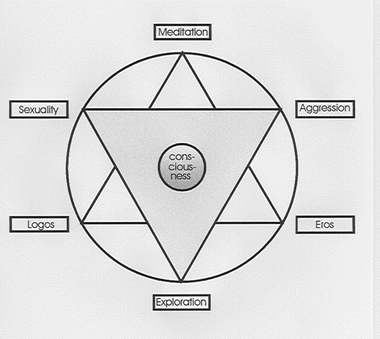 Subsequently,
this god hidden in matter, in the drives of the human body and in the
female principle was able to return to the heavenly realms.
Psychologically, this process involves the construction of a renewed
upper image of God, consisting of the three principles, logos,
meditation and eros, which develop out of the socalled triad of
drives: aggression, exploration and sexuality. This renewed image of
god implies a reunion of the opposites of the two trinities, a
reunion represented by the famos distinctive sign of alchemy, the
Seal of Solomon. Subsequently,
this god hidden in matter, in the drives of the human body and in the
female principle was able to return to the heavenly realms.
Psychologically, this process involves the construction of a renewed
upper image of God, consisting of the three principles, logos,
meditation and eros, which develop out of the socalled triad of
drives: aggression, exploration and sexuality. This renewed image of
god implies a reunion of the opposites of the two trinities, a
reunion represented by the famos distinctive sign of alchemy, the
Seal of Solomon.
Symbolically seen, the third
represents the concept of energy, which is why this new image of god
has to contain the ambivalent energy. In addition to the concept of
physical energy it also contains what Jung called objective psychic
energy. The relatively simultaneous effects of these energies can be
observed in synchronistic phenomena.
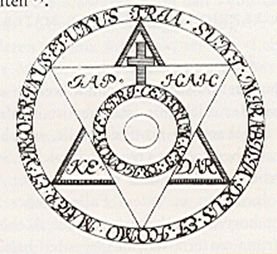 Chapter Four (see Paracelsus
and the Renewed Image of God,
Chapter 4 of Synchronicity Quest)
describes how, in Paracelsus, an antitrinity of matter developed
compensatory to the Christian trinity, which we can equate with the
instinctive principles of aggression, exploration and sexuality. Out
of this compensatory antitrinity a renewed upper trinity, composed of
logos, meditation and eros, is built up in the four-step alchemical
opus. In this renewed image of God the upper trinity replaces the old
Christian, exclusively male one, and with eros it also contains the
female principle. Together with the instinctive trinity of
aggression, exploration and sexuality it forms the new double
trinitarian image of God - the new Zeitgeist is born. The principle
tool for developing this new Zeitgeist is my Body
Centered Visualisation
or - in the case of illness - the Symptom
Symbol Transformation,
a method that combines the method of active imagination developed by
C.G. Jung with intuitive concepts of Paracelsus about the subtle
body, and is based on the concept of synchronicity.
Chapter Four (see Paracelsus
and the Renewed Image of God,
Chapter 4 of Synchronicity Quest)
describes how, in Paracelsus, an antitrinity of matter developed
compensatory to the Christian trinity, which we can equate with the
instinctive principles of aggression, exploration and sexuality. Out
of this compensatory antitrinity a renewed upper trinity, composed of
logos, meditation and eros, is built up in the four-step alchemical
opus. In this renewed image of God the upper trinity replaces the old
Christian, exclusively male one, and with eros it also contains the
female principle. Together with the instinctive trinity of
aggression, exploration and sexuality it forms the new double
trinitarian image of God - the new Zeitgeist is born. The principle
tool for developing this new Zeitgeist is my Body
Centered Visualisation
or - in the case of illness - the Symptom
Symbol Transformation,
a method that combines the method of active imagination developed by
C.G. Jung with intuitive concepts of Paracelsus about the subtle
body, and is based on the concept of synchronicity.
The fifth chapter
(see also The
Wheel Image of Niklaus von Flüe as Symbol of the Subtle
Body) deals with
the visions of the Swiss mystic, Nicholas von Flüe, with how the
new and double triadic image of god developed in him and how he
finally found his famos Radbild (image of the wheel), which seen
symbolically is an equivalent of the alchemical seal of Solomon.
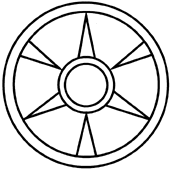 In
the visions of this Swiss saint we not only recognize this goal of
god's transformation, but at the same time the visions show us the
process which leads to this goal. In symbolic language this process
can be described by a metaphor, "the lance pierces the heart", and
the goal of the process by the statement, "the seal of Solomon in the
heart", an image which corresponds to the Radbild of Nicholas of
Flüe. The process as well as its goal can also be seen as the
central contents of the heart chacra (anahata) of Buddhist and Hindu
Tantrism and of Moslem Sufism and in the Germanic myth of Wotan. In
psychological language this myth represents the transformation of
affective impulses and therefore of the psychic energy contained in
the instinctive triad of aggression, exploration and sexuality into
the upper principles of the renewed god image, that is, into the
principles of logos, meditation and eros. In
the visions of this Swiss saint we not only recognize this goal of
god's transformation, but at the same time the visions show us the
process which leads to this goal. In symbolic language this process
can be described by a metaphor, "the lance pierces the heart", and
the goal of the process by the statement, "the seal of Solomon in the
heart", an image which corresponds to the Radbild of Nicholas of
Flüe. The process as well as its goal can also be seen as the
central contents of the heart chacra (anahata) of Buddhist and Hindu
Tantrism and of Moslem Sufism and in the Germanic myth of Wotan. In
psychological language this myth represents the transformation of
affective impulses and therefore of the psychic energy contained in
the instinctive triad of aggression, exploration and sexuality into
the upper principles of the renewed god image, that is, into the
principles of logos, meditation and eros.
To accomplish this the first
step is to introvert the drive to explore. This leads into the
meditative technique of active imagination developed by C.G. Jung. In
the near future - at the beginning of the post-Christian era -
mankind will be forced to begin this transformation process, since
identifying with collective aggression is no longer possible because
of the nuclear bomb and since collective (extraverted) exploration
will be halted by pollution and collective (promiscuous) sexuality by
AIDS.
Active Imagination is based
on synchronicity, a principle which compensates the casuality - the
desolate clockwork fantasy (Jung) - of today's scientific Zeitgeist.
Both Nicholas' Radbild and the seal of Solomon symbolize the
principle of synchronicity, in which relatively simultaneous inner
(dreams, visions) and outer events indicate the way out of the crisis
of our day. In the synchronistic event, the two above mentioned
energies the physical and the objective psychic coincide, and
experience shows that by observing these paranormal events a
potential, new creation of the godhead is discernable. Therefore,
synchronicity compensates the creatio ex nihilo (the unique
creation of the world by God out of nothingness) and replaces it with
the idea of the creatio continua. This revolutionary new
principle means nothing less than that the empirical human being is
forced to observe the transformation of the god image. In this way
new creation is initiated, a creation whose effects we are unable as
yet to observe.
The process thus described in
the first five chapters was repressed by the Christian Fathers' dogma
of God's immutability which prevented the transformation of the deity
from incarnating in the consciousness of human beings. 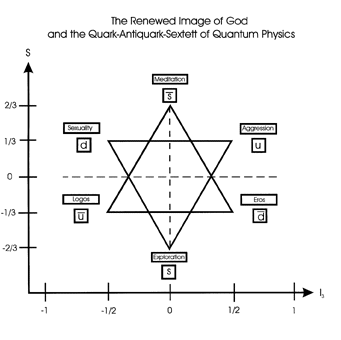 But, as I will show in Chapter Six, during the 20th century, towards
the end of the Christian era, the process of God's transformation
was, with the tools of modern science, once more observed in a
totally unexpected place. For the accelerator and the bubble chamber,
the epistemological instruments of quantum and elementary particle
physics, correspond symbolically to the metaphor "The lance pierces
the heart"; and the goal of the process, the seal of Solomon,
reappears as the so-called quark-antiquark-sextette, a result of the
observation of newly created elementary particles in the bubble
chamber. The quark-antiquark-sextette parallels the main structure of
the atomic nucleus and nuclear force. It corresponds exactly to the
alchemical seal of Solomon and to the Radbild of Nicholas of
Flüe. As mystic symbolism requires, it arises in the "heart" of
the bubble chamber as a result of the piercing lance process.
Psychologically seen, this process involves the introversion of
psychic energy through active imagination, which should begin with
the introversion of the exploratory instinct in order to build up the
upper principle of meditation.
But, as I will show in Chapter Six, during the 20th century, towards
the end of the Christian era, the process of God's transformation
was, with the tools of modern science, once more observed in a
totally unexpected place. For the accelerator and the bubble chamber,
the epistemological instruments of quantum and elementary particle
physics, correspond symbolically to the metaphor "The lance pierces
the heart"; and the goal of the process, the seal of Solomon,
reappears as the so-called quark-antiquark-sextette, a result of the
observation of newly created elementary particles in the bubble
chamber. The quark-antiquark-sextette parallels the main structure of
the atomic nucleus and nuclear force. It corresponds exactly to the
alchemical seal of Solomon and to the Radbild of Nicholas of
Flüe. As mystic symbolism requires, it arises in the "heart" of
the bubble chamber as a result of the piercing lance process.
Psychologically seen, this process involves the introversion of
psychic energy through active imagination, which should begin with
the introversion of the exploratory instinct in order to build up the
upper principle of meditation.
Physics, however, has not yet
been able follow this first of the four steps of Paracelsus' opus.
That is why the process of God's transformation at the end of the
Christian era appears as a projection into matter. Psychologically
seen, Fritjof Capra's "cosmic dance of matter" turns out to be that
unconscious mixture of aggression and sexuality which Paracelsus had
already diagnosed as the principal illness of Christian man. This
eternal dance of matter corresponds also to the prima materia of
alchemy, which Paracelsus meant to transform through his opus. We see
further that Capra's mythological interpretation of physics regresses
behind the insights of the alchemical physician. So the principle of
eros remains projected onto matter into the quark-antiquark-sextette
and into nuclear force. This suggests a great danger, in that western
civilization may fall out of the hitherto existing identification
with logos into an identification with collective eros, which would
mean a regression into the magic world of the Middle Ages. In this
way, ethically responsable consciousness - the great achievement of
Christian culture would be destroyed.
When we examine the symbolism
of the quark-antiquark-sextette from the perspective of Jungian
psychology, we reach the same conclusions we did with the Radbild of
Nicholas of Flüe. There are many indications that the quark
model of quantum physics is comparable to the synchronicity concept
of C.G. Jung, a concept which is strongly connected with the
principle of eros. In order to experience synchronicity consciously,
it is necessary to bild up a new kind of consciousness. This
consciousness ist double, that is, it is simultaneously oriented
outwards and inwards (extraverted and introverted), and it underlies
the condition of the so called "contingent spacetime". In this way,
it is also able to transform instinctive energy by means of active
imagination. This transformation appears to be sufficient for
consciously observing the phenomena of synchronicity.
Nuclear force is acausal,
because it is only possible as the result of the uncertainty
principle, formulated by Werner Heisenberg. I will show that this
physical nuclear force, phenomenologically seen, corresponds to the
principle of acausal orderedness, postulated by C.G. Jung. After a
certain level of energy, nuclear force is accompanied with so called
strangeness, which itself corresponds to the principle of
synchronicity. And behind this principle lies objective psychic
energy.
Therefore we must expect
that, after a critical point, parallel to the energizing of matter
and the production of artificial radioactivity in the nuclear
reactors, events will occur in which objective psychic energy is
manifested. It is very likely that mankind will experience this
objective psychic energy in the mass hysteria of a supposed invasion
of extraterrestrials with their UFOs. The only chance of avoiding
this catastrophe lies in an appreciation of the reality of objective
psychic energy and the above mentioned transformation of the ego,
which corresponds to the transformation of the god image during the
2000 years of Christianity.
A dream of Wolfgang Pauli,
the famos physicist and Nobel Laureate, which he had in the early
fifties (that is, prior to the formulation of the quark theory)
verifies the hypothesis that quantum physics is unconsciously seeking
synchronicity as a supplementary principle of explanation. Further
this dream shows, that we will find this new principle - and in this
way find the consciously lived principle of eros - only by a new
science, a reunion of physical theory and depthpsychological
experience, which begins with the introversion of the exploratory
instinct. This new science deals with the nonphysical role of so
called "negative energy" of physics in the subtle-body reality of the
objective psyche beyond the split between matter and
spirit.
******
Englisch Homepage of Remo F.
Roth
The
Connection between Radioactivity and Synchronicity in the Pauli/Jung
Letters
Deutsche Hompage von Remo F.
Roth
Radioaktivität
und Synchronizität im Briefwechel zwischen Wolfgang Pauli und
C.G. Jung
back

|